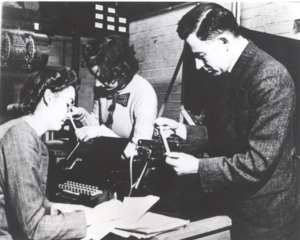Dr Roger Johnson, Fellow of Birkbeck College and Emeritus Reader in Computer Science, reflects on the world’s first stored program computer as created and demonstrated by Professor Andrew Booth and Kathleen Booth (née Britten) 75 years ago.
At the heart of the modern computer is a memory that holds both the program to be run and the data to be processed. The first successful demonstration of the modern computer was by two members of staff from Birkbeck College: Andrew and Kathleen Booth.
Starting in the late summer of 1947, they designed and then built a computer which they called ARC (Automatic Relay Computer). The first public demonstration of the computer was on May 12th 1948 – exactly 75 years ago.
Kathleen and Andrew Booth shared the task of building the computer helped by one research assistant, Xenia Sweeting.
In accounts of her work, Kathleen Booth, who wrote the first program, recounted: “We demonstrated the generation and printing of a table of the squares of the natural numbers 0-255 in the scale of 10”.
Technically, the computer’s memory was a brass drum with an oxide coating which could store in total 256 words each of 21 bits revolving at 3000 revolutions per minute. By modern standards, this is absolutely tiny, but was significant for the time. The computer was also very slow by today’s standards because the logic of the computer was built using relays.
However, from this first basic computer have developed the massively powerful modern computers which can run programs of a complexity which few even dreamt of in those early days.
Further Information:




